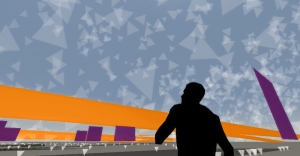http://www.idialabprojects.org/displacedresonance/virtual.html
PROXY
John Fillwalk
with Michael Olson, Composer and IDIA Lab. 2012.
In the virtual installation, PROXY, visitors shape the construction of a sculptural and sonic response to the virtual museum. The work progresses to form, eventually transforming to become structural support for the building. When multiple users are in the environment, their avatars interact with one another to create collaborative painting and sculpture.
FLICKR™ GETTR v6
John Fillwalk
with Jesse Allison, Composer and IDIA Lab. 2012.
FLICKR™ GETTR v6 connects the social image web service of Flickr™ to the virtual museum environment, allowing visitors to create a dynamic cloud of spatial imagery by entering a search term of their choice, that pulls in related images from Flickr™ into the virtual environment.
SURVEY FOR BEIJING
John Fillwalk
with Keith Kothman, Composer and IDIA Lab. 2012.
SURVEY FOR BEIJING is an immersive landscape simulation using real time weather data from the physical location in Beijing, China. Representations of surveyor’s tape, flags, light, time of day, wind and clouds are superimposed onto the virtual landscape in accordance with real-life weather data.
con|FLUENCE
John Fillwalk
with Michael Olson, Composer and IDIA Lab. 2012.
Participants in con|FLUENCE create pathways based on reactions to both social and spatial relationships. There is a virtual response and persistence to interactions, as the routes are drawn and sculpted in the three-dimensional environment – forming nodes that are created via visitors’ proximity
Third Art and Science International Exhibition
China Science and Technology Museum in Beijing
http://www.tasie.org.cn/index.asp
TASIE Press release
http://www.tasie.org.cn/content_e.asp?id=84
Ball State artists create “forest” of light on display in China and Internet
Muncie, Ind. — Ball State University electronic artists have created a “forest” of light and sound that will be on exhibit in Beijing, China through November, yet also accessible to visitors from Indiana or anywhere else in the world.
That’s possible because “Displaced Resonance,” as the interactive art exhibit is known, has both real-life and virtual components.
The physical portion has been installed in a gallery of the China Science and Technology Museum in Beijing. There, in-person visitors can negotiate a thicket of 16 interactive sculptures spaced 1.5 meters apart that will change colors and emit music as they approach.
A digital replica of the layout, meanwhile, resides on the Internet, accessible through the museum’s website. Online visitors can wander the virtual exhibit using an avatar, and the digital pillars will change colors and produce sounds, just like their physical counterparts.
But that’s not all — the two pieces interact with each other, says John Fillwalk, director of Ball State’s Institute for Digital Intermedia Arts (IDIA) and Hybrid Design Technologies (HDT), which created the work in collaboration with IDIA staff, students and composer Michaal Pounds, BSU.
When an online avatar approaches a virtual pillar, the corresponding real-life column also will change colors, and vice versa. In-person and virtual visitors will produce different colors, however, allowing them to track each other through the exhibit.
“It’s what we call hybrid art,” says Fillwalk. “It’s negotiating between the physical world and the virtual. So it’s both sets of realities, and there’s a connection between the two.”
The physical pillars are two meters (or more than 6 feet, 6 inches) tall. They consist of a wooden base containing a sound system; a translucent pillar made of white corrugated plastic and computer-controlled lighting.
A thermal camera mounted on the museum’s ceiling keeps track of visitors and feeds its data to a computer program that directs the columns to change color and broadcast sounds when someone draws near.
“It’s a sensory forest that you can navigate,” Fillwalk says.
Two final touches: a video screen mounted on a museum wall overlooking the exhibit allows in-person visitors to watch avatars move around the virtual version, while Internet patrons can keeps tabs on the real-life display through a window on their computer screens.
“Displaced Resonance” is the centerpiece of Ball State’s contributions to the Beijing museum’s 3rd Art and Science International Exhibition and Symposium, a month-long celebration of technology and the arts. Ball State was invited to participate because museum curators discovered some of IDIA’s work and liked what they saw, Fillwalk said.
In addition to “Displaced Resonance,” IDIA contributed four other pieces of digital art that museum visitors can view at a kiosk.
Those pieces are:
· “Proxy”, in which visitors create, color and sculpt with floating 3D pixels.
· “Flickr Gettr,” in which visitors can surround themselves with photos from the Flickr web service that correspond to search terms they submit.
· “Confluence,” in which users create virtual sculptures by moving around the screen and leaving a path in their wake.
· “Survey for Beijing,” in which real time weather data from Beijing is dynamically visualized in a virtual environment.
(Note to editors: For more information, contact John Fillwalk, director of the Institute for Digital Intermedia Arts, at765-285-1045 or jfillwalk@bsu.edu; or Vic Caleca, media relations manager, at 765-285-5948, or vjcaleca@bsu.edu. For more stories, visit the Ball State University News Center at www.bsu.edu/news.
